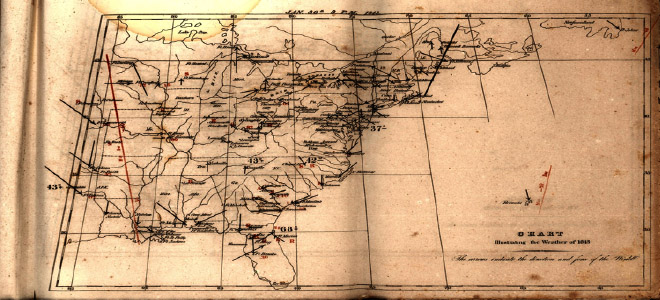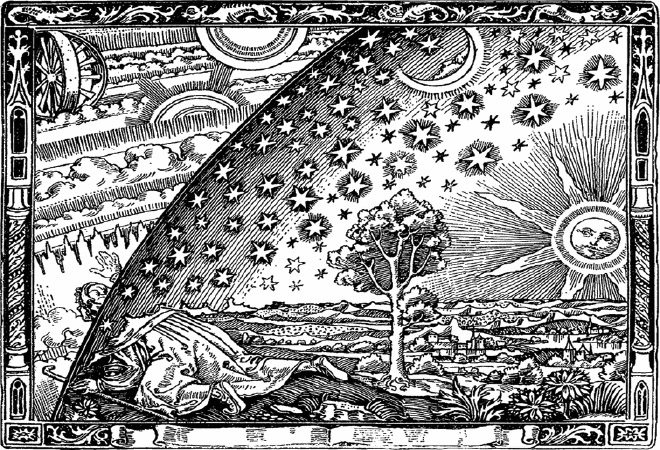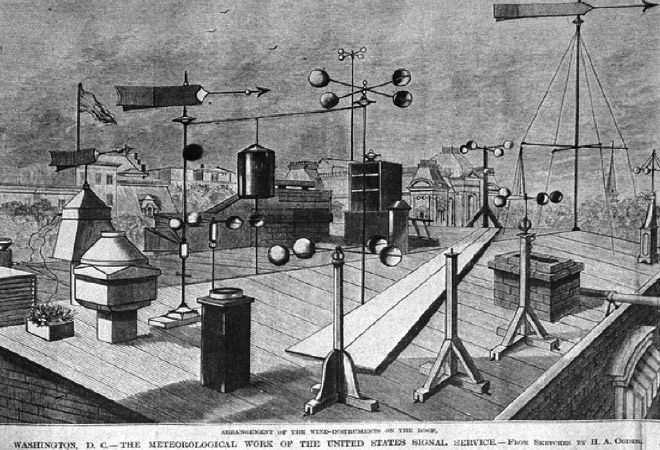
by Julia Schubert
Fulbright Doctoral Visiting Scholar at CIRES Center for Science and Technology Policy Research
University of Colorado at Boulder
(Image above: Oldest series of weather maps in the United States. January 30, 1843. Produced by James Pollard Espy. Source: Image ID: wea05013, NOAA’s National Weather Service (NWS) Collection.)
Climate change is arguably one of the most prominent and pressing problems of our time. While the atomic threat dominated the 1960s, and awareness of environmental risks arose predominantly in the 1970s, anthropogenic climate change significantly shapes the beginning of the 21st century as its defining challenge. But how exactly was this issue of climate change discovered? How did it emerge as the epitome of a modern ‘Grand Societal Challenge’ as displayed in countless political pamphlets and organizational mission statements? And, going even further, how do societal problems in general arise?
The simple answer is: We fabricate them. Or, more precisely, they are historically and culturally contingent – building on observations shaping and institutions stabilizing them. These contingent and fragile problem ‘framings’ are thus defined by distinct societal (e.g. religious, scientific, political or economic) observations. And the assertiveness of these observations is in turn dependent on their stabilization in respective institutions, perpetuating a distinct problem-frame. Following this perspective, problems are far from being simply given. Retracing the diverse historical trajectories of climate change as a modern ‘Grand Challenge’, thus illustrates the fundamentally social construction of societal problems. This, of course, does not question or even regard the physical underpinnings of anthropogenic climate change. It rather emphasizes that we are fundamentally shaping its necessarily social reality and therein its configuration as a ‘Grand Societal Challenge’.
Changing and disruptive climatic conditions were observed as early as at the beginning of the 17th century (cf. Parker 2013), some scholars even argue for first observations of climatic change being made in antiquity (cf. Fleming 1998: 137). Importantly differing from modern observations of anthropogenic climate change, however, at the time only isolated catastrophic incidents were captured, rather than a global trend. These early disruptive climatic events such as ‘the year without a summer’ in 1814 were largely attributed to the sphere of the gods. Catastrophic climatic change, in its historical antecedent, was observed and stabilized as a religious problem (see also Hulme 2014: 12).
 Wood Carving by Unknown Artist in Flammarion, C. (1888). L’atmosphère: Météorologie Populaire. Hachette. Source: Wikipedia.
Wood Carving by Unknown Artist in Flammarion, C. (1888). L’atmosphère: Météorologie Populaire. Hachette. Source: Wikipedia.
For early and colonial America, climate change was a matter of national pride and an essential component of the emerging Republican national ideal. The vision was that clearing and cultivating the land would promote a warmer, less variable, and healthier climate. Thomas Jefferson was already a pronounced advocate of comprehensive meteorological measurements – yet without reliable instruments or sponsoring institutions (cf. Fleming 1998: 33). Only in the late 19th century scholars such as Svante Arrhenius (1896, 1908) and Nils Gustaf Ekholm (1901) began to systematically explore the relation of climate and society—tabulating, charting, and mapping their observations and the possibility of global anthropogenic climate change. The establishment of national weather services in Europe, Russia, and the United States allowed for the further standardization of climatic observations. Later, this led to international cooperation and even the establishment of global observation systems, significantly broadening its geographic scope (cf. Fleming 1998: 41). Thus, based on the invention of meteorological observation systems and statistical analysis, a first scientific picture of anthropogenic climate change had been stabilized, discovering and addressing it as a physical phenomenon. A pressing problem, however, was not yet in sight.
 Arrangement of the wind instruments on the roof of the Headquarters Building of the Meteorological Service of the United States Signal Service. Source: Image ID: wea01316, NOAA’s National Weather Service (NWS) Collection, 1880, Archival Photograph by Mr. Steve Nicklas, NOS, NGS.
Arrangement of the wind instruments on the roof of the Headquarters Building of the Meteorological Service of the United States Signal Service. Source: Image ID: wea01316, NOAA’s National Weather Service (NWS) Collection, 1880, Archival Photograph by Mr. Steve Nicklas, NOS, NGS.
It was not before the 1950s, that global warming appeared on the public agenda as a first problematic version of anthropogenic climate change, immediately followed by the discussion of global cooling and the dawn of a new ice age in the 1970s. Again, scientific observation was of essence here and the cooling hypothesis was rather quickly rejected. At the end of the 20th century this problematic observation of global anthropogenic climate change was institutionalized – a final essential step in the discovery of anthropogenic climate change as a ‘Grand Societal Challenge’. Milestones in this certification of the problem as a global issue were, for example, the establishment of the Intergovernmental Panel on Climate Change (IPCC) in 1988 and the United Nations Framework Convention on Climate Change (UNFCCC) in 1992.
Building on this institutionalization of climate change as a pressing societal problem, various responses were suggested as viable and legitimate: From the scientific challenge posed by the urgent need for better observation systems, or the political challenge of coordinating climate-friendly behavior, to the recently declared technological challenge of actively engineering the climate system to halt dangerous climate change – in each of these versions, climate change is defined as a distinct societal challenge.
Summing up, this short account of the discovery of climate change as a ‘Grand Societal Challenge’ illustrates the complex social presuppositions aiding in the historical evolution, emergence, and addressing of societal problems: Beginning with antecedent religious observations of catastrophic climatic variations, and initial meteorological measuring efforts driven by national political ideals, to the emergence of a first scientific picture of anthropogenic climate change, global warming (and cooling) finally emerged as a ‘Grand Societal Challenge’. Thus, throughout its history, the fragile problem of climate change is building on distinct observations that are in turn fundamentally bound to specific instruments, organizations and, more generally, a historically contingent problem-infrastructure.
 Mauna Loa Observatory; National Oceanic and Atmospheric Association.
Mauna Loa Observatory; National Oceanic and Atmospheric Association.
References:
Arrhenius, S. (1896). XXXI. On the Influence of Carbonic Acid in the Air Upon the Temperature of the Ground. The London, Edinburgh, and Dublin Philosophical Magazine and Journal of Science, 41(251), 237–276.
Ekholm, N. (1901). On the Variations of the Climate of the Geological and Historical Past and Their Causes. Quarterly Journal of the Royal Meteorological Society, 27(117), 1–62.
Fleming, J. R. (1998). Historical perspectives on climate change. Oxford University Press.
Hulme, M. (2014). Can Science Fix Climate Change? A Case Against Climate Engineering.
Parker, G. (2013). Global crisis: war, climate change and catastrophe in the seventeenth century. New Haven: Yale University Press.


Climate Change: The Discovery of a Grand Societal Challenge
by Julia Schubert
Fulbright Doctoral Visiting Scholar at CIRES Center for Science and Technology Policy Research
University of Colorado at Boulder
(Image above: Oldest series of weather maps in the United States. January 30, 1843. Produced by James Pollard Espy. Source: Image ID: wea05013, NOAA’s National Weather Service (NWS) Collection.)
Climate change is arguably one of the most prominent and pressing problems of our time. While the atomic threat dominated the 1960s, and awareness of environmental risks arose predominantly in the 1970s, anthropogenic climate change significantly shapes the beginning of the 21st century as its defining challenge. But how exactly was this issue of climate change discovered? How did it emerge as the epitome of a modern ‘Grand Societal Challenge’ as displayed in countless political pamphlets and organizational mission statements? And, going even further, how do societal problems in general arise?
The simple answer is: We fabricate them. Or, more precisely, they are historically and culturally contingent – building on observations shaping and institutions stabilizing them. These contingent and fragile problem ‘framings’ are thus defined by distinct societal (e.g. religious, scientific, political or economic) observations. And the assertiveness of these observations is in turn dependent on their stabilization in respective institutions, perpetuating a distinct problem-frame. Following this perspective, problems are far from being simply given. Retracing the diverse historical trajectories of climate change as a modern ‘Grand Challenge’, thus illustrates the fundamentally social construction of societal problems. This, of course, does not question or even regard the physical underpinnings of anthropogenic climate change. It rather emphasizes that we are fundamentally shaping its necessarily social reality and therein its configuration as a ‘Grand Societal Challenge’.
Changing and disruptive climatic conditions were observed as early as at the beginning of the 17th century (cf. Parker 2013), some scholars even argue for first observations of climatic change being made in antiquity (cf. Fleming 1998: 137). Importantly differing from modern observations of anthropogenic climate change, however, at the time only isolated catastrophic incidents were captured, rather than a global trend. These early disruptive climatic events such as ‘the year without a summer’ in 1814 were largely attributed to the sphere of the gods. Catastrophic climatic change, in its historical antecedent, was observed and stabilized as a religious problem (see also Hulme 2014: 12).
For early and colonial America, climate change was a matter of national pride and an essential component of the emerging Republican national ideal. The vision was that clearing and cultivating the land would promote a warmer, less variable, and healthier climate. Thomas Jefferson was already a pronounced advocate of comprehensive meteorological measurements – yet without reliable instruments or sponsoring institutions (cf. Fleming 1998: 33). Only in the late 19th century scholars such as Svante Arrhenius (1896, 1908) and Nils Gustaf Ekholm (1901) began to systematically explore the relation of climate and society—tabulating, charting, and mapping their observations and the possibility of global anthropogenic climate change. The establishment of national weather services in Europe, Russia, and the United States allowed for the further standardization of climatic observations. Later, this led to international cooperation and even the establishment of global observation systems, significantly broadening its geographic scope (cf. Fleming 1998: 41). Thus, based on the invention of meteorological observation systems and statistical analysis, a first scientific picture of anthropogenic climate change had been stabilized, discovering and addressing it as a physical phenomenon. A pressing problem, however, was not yet in sight.
It was not before the 1950s, that global warming appeared on the public agenda as a first problematic version of anthropogenic climate change, immediately followed by the discussion of global cooling and the dawn of a new ice age in the 1970s. Again, scientific observation was of essence here and the cooling hypothesis was rather quickly rejected. At the end of the 20th century this problematic observation of global anthropogenic climate change was institutionalized – a final essential step in the discovery of anthropogenic climate change as a ‘Grand Societal Challenge’. Milestones in this certification of the problem as a global issue were, for example, the establishment of the Intergovernmental Panel on Climate Change (IPCC) in 1988 and the United Nations Framework Convention on Climate Change (UNFCCC) in 1992.
Building on this institutionalization of climate change as a pressing societal problem, various responses were suggested as viable and legitimate: From the scientific challenge posed by the urgent need for better observation systems, or the political challenge of coordinating climate-friendly behavior, to the recently declared technological challenge of actively engineering the climate system to halt dangerous climate change – in each of these versions, climate change is defined as a distinct societal challenge.
Summing up, this short account of the discovery of climate change as a ‘Grand Societal Challenge’ illustrates the complex social presuppositions aiding in the historical evolution, emergence, and addressing of societal problems: Beginning with antecedent religious observations of catastrophic climatic variations, and initial meteorological measuring efforts driven by national political ideals, to the emergence of a first scientific picture of anthropogenic climate change, global warming (and cooling) finally emerged as a ‘Grand Societal Challenge’. Thus, throughout its history, the fragile problem of climate change is building on distinct observations that are in turn fundamentally bound to specific instruments, organizations and, more generally, a historically contingent problem-infrastructure.
References:
Arrhenius, S. (1896). XXXI. On the Influence of Carbonic Acid in the Air Upon the Temperature of the Ground. The London, Edinburgh, and Dublin Philosophical Magazine and Journal of Science, 41(251), 237–276.
Ekholm, N. (1901). On the Variations of the Climate of the Geological and Historical Past and Their Causes. Quarterly Journal of the Royal Meteorological Society, 27(117), 1–62.
Fleming, J. R. (1998). Historical perspectives on climate change. Oxford University Press.
Hulme, M. (2014). Can Science Fix Climate Change? A Case Against Climate Engineering.
Parker, G. (2013). Global crisis: war, climate change and catastrophe in the seventeenth century. New Haven: Yale University Press.